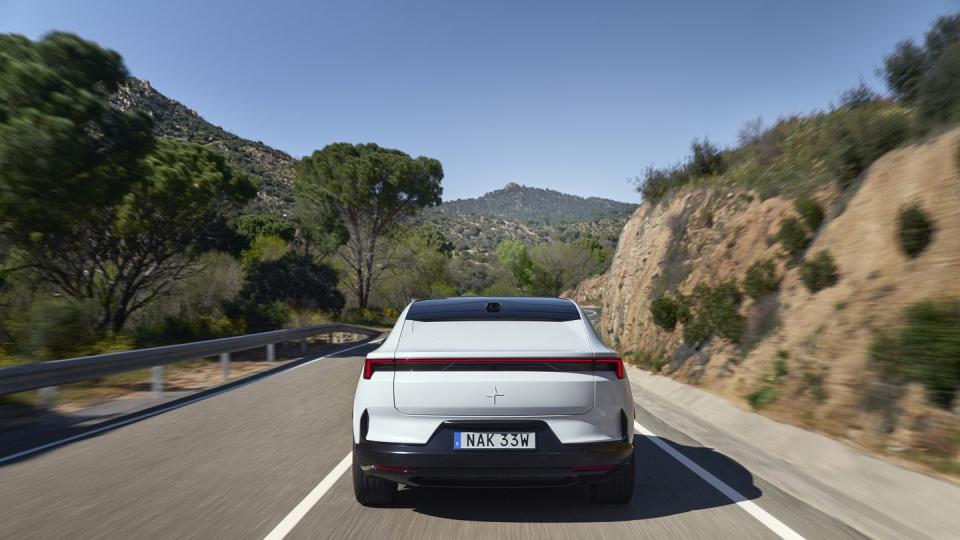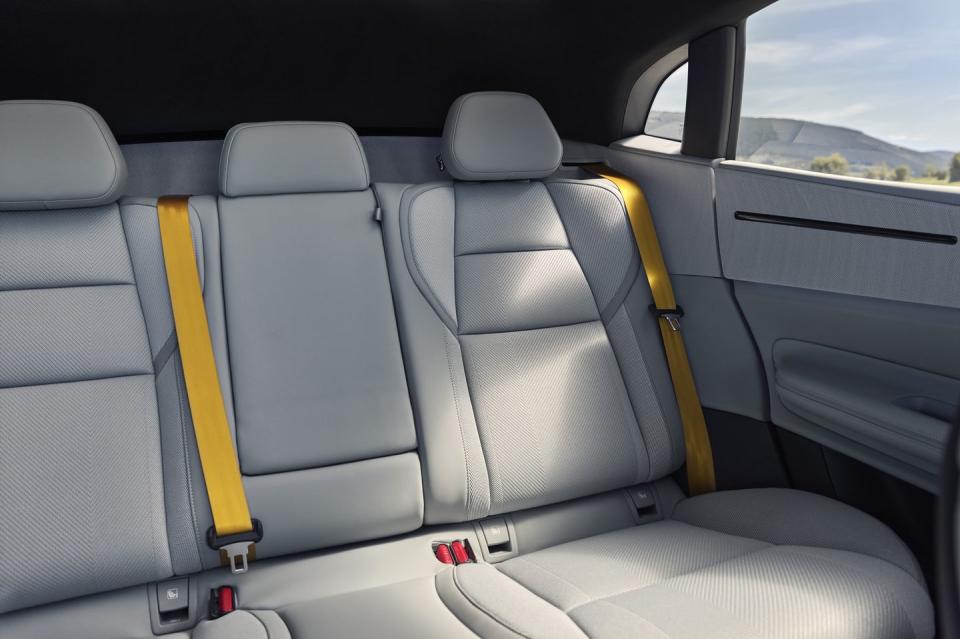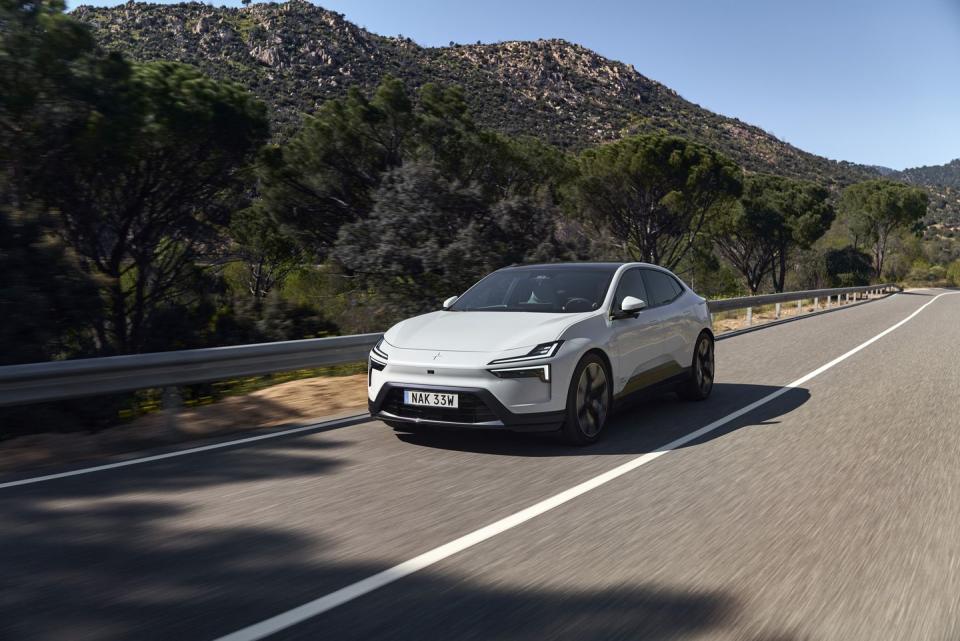2025 Polestar 4 Is a Sleek, Rear-Windowless Electric Spaceship

The first thing that stands out about the 2025 Polestar 4 is actually what's missing: a rear window. The absence of glass isn't just a slick styling cue; Polestar says it opens up more headroom despite the 4's trendy—and aerodynamically beneficial—sloping roofline. But the Polestar 4 is more than just its unorthodox glassless rear end, proving to be quick and smooth on the winding roads outside Madrid with a comfortable, high-tech interior to boot. While not quite as dynamically polished as its big brother, the Polestar 3, the 4's more attractive starting price offsets its minor flaws.
There are two powertrains available in the Polestar 4, with the base setup's single 268-hp motor spinning the rear wheels and sending the SUV from zero to 62 mph in a claimed 7.1 seconds. The dual-motor, all-wheel-drive arrangement adds an electric motor up front and produces 536 horsepower and 506 pound-feet of torque; adaptive dampers come along for the ride too. The dual-motor Polestar 4 we drove was equipped with the Performance package, adding 22-inch forged wheels, aluminum four-piston Brembo brake calipers, and more serious Pirelli P Zero summer rubber. The Performance pack also injects visual pizzazz with gold seatbelts and valve stem caps.

The dual-motor 4 is both rapid and fairly nimble, with Polestar claiming a 3.8-second sprint to 62 mph, which would make the 4 the quickest Polestar yet. In its softest setting, the ride felt silky smooth, and while the adaptive dampers' firmest mode introduced some bumps into cabin, it mitigated body roll and still rounded out the jolts enough so as to be not intrusive. Madrid's roads were in far better shape than Michigan's pockmarked pavement, however, so we look forward to testing the 4 on home soil. But the best part of all? Unlike the Polestar 1 and 2's immensely capable yet immensely difficult to adjust Öhlins dampers, you adjust the 4's suspension through the infotainment display.
While the 4 is punchy and feels reasonably planted in corners, the controls—steering wheel, accelerator, and brake pedal—feel distant. Briskly driving the 4 produces no drama, but it also elicits no emotion. While the pricier Polestar 3 won't rival a Subaru BRZ for steering feel, its torque-vectoring rear differential separates it from the 4 with more engaging handling. The 4's brakes feel strong but aloof, and the initial bite can be grabby at lower speeds.
All Polestar 4s utilize the same 94.0-kWh battery, which Polestar claims yields up to 300 miles of range. The dual-motor setup should knock that down to around 270 miles, but it'll be some time before the EPA weighs in. A 400-volt electrical architecture helps the 4 slurp up to 200 kilowatts from a DC fast-charger, enough to take the battery from 10 to 80 percent in 30 minutes, Polestar says. All 4s also have a heat pump to improve efficiency and charging speeds in cold climates. The regenerative braking offers three levels of adjustment, and a creep function lets you inch forward in traffic while keeping the highest regen setting activated.

Since the Polestar 4 eschews a back window, the rearward view arrives solely via a roof-mounted camera and digital mirror. Those who have used digital rearview mirrors before shouldn't have any issues, but for the less technologically proficient, the digital mirror may require some adjustment since it's harder to get a realistic sense of depth from the screen.
Although we didn't mind the setup, it ultimately felt like Polestar is solving a problem that doesn't really exist. The headroom improvements seem minimal, and the top of this 5-foot-11-inch author's hair still brushed the headliner. The field of view is definitely wider than with a traditional mirror—and the view angles four degrees left or right when the turn signal is on and tilts slightly down when reversing—but the benefit isn't quite as revolutionary as Polestar suggests. Still, the display is clear and minimizes the flicker from LED headlights behind.
Look down from the digital display and you'll find a cabin that is minimalist but not bare, exuding a quiet, understated luxury. The seats are firm but supportive. Soft-touch materials abound, and they mostly feel high-quality, although the sportswear-inspired weave made from recycled plastic bottles definitely felt more, well, plasticky than luxurious. Luckily other upholstery options are available. The extra headroom afforded by the missing rear window let Polestar shift the rear seats a bit farther back, and thus legroom is plentiful.

The dashboard is dominated by a 15.4-inch horizontally oriented touchscreen running Polestar's latest Google-based infotainment system. The interface is crisp and easy to read thanks to bold fonts and contrasting colors. The well-organized display is customizable: A split-screen function shows multiple applications at once, and the 4 can store up to six different driver profiles to save preferred settings. However, the digital buttons could be a tad larger—we found it tricky to consistently press the right spot while driving, and nearly every function is controlled through that screen.
The 4 separates itself from the more sophisticated Polestar 3 with fun celestial-themed graphics for each different ambient lighting color. Every hue corresponds to a planet, and the screen displays intricate animations of the planets with key facts about each. Occasionally, a Polestar 4 zips by in virtual outer space.
The Polestar 4 we drove also included the Plus package, adding goodies like a 14.7-inch head-up display, electric reclining rear seats, and a 12-speaker Harman/Kardon sound system. The latter can be upgraded with two extra speakers in each front headrest that allow the driver to take calls or hear navigation instructions while passengers can enjoy music sans interruption.

We also experienced the Pilot pack, which adds a suite of radar, ultrasonic sensors, and cameras. These parts work together to control the Pilot Assist system that can steer, adjust the 4's speed, and execute lane changes. As in the Polestar 3, we came away impressed with Pilot Assist but found the lane-keeping aid to be overly proactive, although Spain's narrow lanes might be the real culprit there.
The Polestar 4 will take up arms against the upcoming Porsche Macan EV and Audi Q6 e-tron, as well as shoppers considering the cheaper Tesla Model Y. While the Polestar 4 has its work cut out against machines from more established brands when it arrives later this year, the bigger challenge—at least initially—will be its assembly. The Polestar 4 is being built in China before U.S.-bound production shifts to South Korea in 2025, which means any early models destined for the States will come slathered in sticker-swelling tariffs. Even after production shifts to Korea, the 4's batteries will still be sourced from China, keeping matters nice and complicated. Just how consumers like it.

Before taking any future tariffs into account, the Polestar 4 will undercut its pricier German rivals, with the single-motor variant starting at $56,300 and the dual-motor version opening at $64,300. While not exactly cheap, the Polestar 4 provides a whole lot for the price. Streamlined looks, a high-tech and well-appointed cabin, and decent—if a bit boring—driving dynamics make the Polestar 4 an attractive package, as long as you can handle that missing glass.
You Might Also Like

 Yahoo Autos
Yahoo Autos 